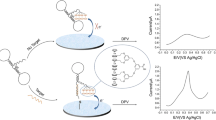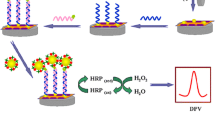Abstract
An electrochemiluminescent (ECL) sensor is presented for the detection of DNA hybridization using single-strand DNA with stem–loop structure as capture probes. After the probe DNA was immobilized on an gold electrode, labeled with ruthenium complex, and formed a stem–loop structure, this sensor produced a high ECL signal. On hybridization with the complementary target DNA, the ECL intensity significantly decreased. Different from other DNA sensors, in which the probe DNA was labeled in advance with a signalling molecule and then assembled onto an electrode, the approach presented here relies on assembling first, and then labelling with ruthenium complex, without the complicated purifying processes after the probe DNA was labeled. The ECL intensity versus the concentration of the target DNA was linear in the range from 1.0 pM to 0.1 µM with a detection limit of 0.5 pM. The biosensor conceivably can be used as a general approach for the ECL detection of DNA.





Similar content being viewed by others
References
Sassolas A, Leca-Bouvier BD, Blum LJ (2008) DNA biosensors and microarrays. Chem Rev 108:109–139
Zhou X, Zhou J (2004) Improving the signal sensitivity and photostability of DNA hybridizations on microarrays by using dye-doped core-shell silica nanoparticles. Anal Chem 76:5302–5312
Liu XJ, Tan WH (1999) A fiber-optic evanescent wave DNA biosensor based on novel molecular beacon. Anal Chem 71:5054–5059
Mallard F, Marchand G, Ginot F, Campagnolo R (2005) Opto-electronic DNA chip: high performance chip reading with an all-electric interface. Biosens Bioelectron 20:1813–1820
Yao X, Li X, Toledo F, Zurita-Lopez C, Gutova M, Momand J, Zhou FM (2006) Sub-attomole oligonucleotide and p53 cDNA determinations via a high-resolution surface plasmon resonance combined with oligonucleotide-capped gold nanoparticle signal amplification. Anal Biochem 354:220–228
Xie H, Zhang CY, Gao ZQ (2004) Amperometric detection of nucleic acid at femtomolar levels with a nucleic acid/electrochemical activator bilayer on gold electrode. Anal Chem 76:1611–1617
Wang J, Li JH, Baca AJ, Hu JB, Zhou FM, Yan W, Pang DW (2003) Amplified voltammetric detection of DNA hybridization via oxidation of ferrocene caps on gold nanoparticle/streptavidin conjugates. Anal Chem 75:3941–3945
Fan CH, Plaxco KW, Heeger AJ (2003) Electrochemical interrogation of conformational changes as a reagentless method for the sequence-specific detection of DNA. Proc Natl Acad Sci USA 100:9134–9137
Lai RY, Lagally ET, Lee SH, Soh HT, Plaxco KW, Heeger AJ (2006) Rapid, sequence-specific detection of unpurified PCR amplicons via a reusable, electrochemical sensor. Proc Natl Acad Sci USA 203:4017–4021
Liu G, Wan Y, Gau V, Zhang J, Wang LH, Song SP, Fan CH (2008) An enzyme-based E-DNA sensor for sequence-specific detection of femtomolar DNA targets. J Am Chem Soc 130:6820–6825
Jin Y, Yao X, Liu Q, Li J (2007) Hairpin DNA probe based electrochemical biosensor using methylene blue as hybridization indicator. Biosens Bioelectron 22:1126–1130
Peng H, Soeller C, Vigar NA, Caprio V, Travas-Sejdic J (2007) Label-free detection of DNA hybridization based on a novel functionalized conducting polymer. Biosens Bioelectron 22:1868–1873
Ricci F, Plaxco KW (2008) E-DNA sensors for convenient, label-free electrochemical detection of hybridization. Microchim Acta 163:149–155
Yang ML, Liu CZ, Qian KJ, He PG, Fang YZ (2002) Study on the electrochemiluminescence behavior of ABEI and its application in DNA hybridization analysis. Analyst 127:1267–1271
Miao WJ, Bard AJ (2004) Electrogenerated chemiluminescence. 77. DNA hybridization detection at high amplification with [Ru(bpy) 3]2+-containing microspheres. Anal Chem 76:5379–5386
Miao WJ, Bard AJ (2003) Electrogenerated chemiluminescence. 72. Determination of immobilized DNA and c-reactive protein on Au(111) electrodes using tris(2, 2′-bipyridyl) ruthenium(II) labels. Anal Chem 75:5825–5834
Wang H, Zhang CX, Li Y, Qi HL (2006) Electrogenerated chemiluminescence detection for deoxyribonucleic acid hybridization based on gold nanoparticles carrying multiple probes. Anal Chim Acta 575:205–211
Li Y, Qi HL, Fang F, Zhang CX (2007) Ultrasensitive electrogenerated chemiluminescence detection of DNA hybridization using carbon-nanotubes loaded with tris(2, 2′-bipyridyl) ruthenium derivative tags. Talanta 72:1704–1709
Zhang J, Qi HL, Li Y, Yang J, Gao Q, Zhang CX (2008) Electrogenerated chemiluminescence DNA biosensor based on hairpin DNA probe labeled with ruthemium complex. Anal Chem 80:2888–2894
Li Y, Qi HL, Yang J, Zhang CX (2009) Detection of DNA immobilized on bare gold electrodes and gold nanoparticle-modified electrodes via electrogenerated chemiluminescence using a ruthenium complex as a tag. Microchim Acta 164:69–76
Hook F, Ray A, Norden B, Kasemo B (2001) Characterization of PNA and DNA immobilization and subsequent hybridization with DNA using acoustic-shear-wave attenuation measurements. Langmuir 17:8305–8312
Su XD, Robelek R, Wu YJ, Wang GY, Knoll W (2004) Detection of point mutation and insertion mutations in DNA using QCM and MutS, a mutation binding protein. Anal Chem 76:489–494
Tyagi S, Kramer FR (1996) Molecular beacons: probes that fluorescence upon hybridization. Nat Biotechnol 14:303–308
Tyagi S, Kramer FR (1999) hermodynamic basis of the enhanced specificity of molecular beacons. Proc Natl Acad Sci USA 96:6171–6176
Kang Y, Feng KJ, Chen JW, Jiang JH, Shen GL, Yu RQ (2008) Electrochemical detection of thrombin by sandwich approach using antibody and aptamer. Bioelectrochemistry 73:76–81
Steel AB, Herne TM, Tarlov MJ (1998) Electrochemical quantitation of DNA immobilized on gold. Anal Chem 70:4670–4677
Shen L, Chen Z, Li YH, Jing P, Xie SB, He SL, He PL, Shao YH (2007) A chronocoulometric aptamer sensor for adenosine monophosphate. Chem Comm 21:2169–2171
Bard AJ, Faulkner LR (2001) Electrochemical methods: Fundamentals and applications, 2nd edn. Wiley, New York
Bertolino C, MacSweeney M, Tobin J, O’Neill B, Sheehanb MM, Coluccia S, Berney H (2005) A monolithic silicon based integrated signal generation and detection system for monitoring DNA hybridization. Biosens Bioelectron 21:565–573
Wang HY, Zhang XL, Tan ZA, Yao W, Wang L (2008) Enhanced electrogenerated chemiluminescence of Ru(bpy) 2+3 /TPrA system on CdS nanocrystals film. Electrochem Commun 10:170–174
Zhang LH, Dong SJ (2006) Electrogenerated chemiluminescence sensors using Ru(bpy) 2+3 doped in silica nanoparticles. Anal Chem 78:5119–5123
Zu YB, Bard AJ (2001) Electrogenerated chemiluminescence. 67. Dependence of light emission of the tris(2, 2′-bipyridyl) ruthenium(II)/tripropylamine system on electrode surface hydrophobicity. Anal Chem 73:3960–3964
Du H, Strobhsahl CM, Camera J, Miller BL, Krauss TD (2005) Sensitivity and specificity of metal surface-immobilized ‘molecular beacon’ biosensors. J Am Chem Soc 127:7932–7940
Acknowledgments
We gratefully acknowledge the support of the National Natural Science Foundation of China (No. 20575001, 20705002) and the Project Sponsored by the Scientific Research Foundation for the Returned Overseas Chinese Scholars, State Education Ministry.
Author information
Authors and Affiliations
Corresponding author
Rights and permissions
About this article
Cite this article
Yao, W., Wang, L., Wang, H. et al. Electrochemiluminescent sensor for the detection of DNA hybridization using stem-loop structure DNA as capture probes. Microchim Acta 165, 407–413 (2009). https://doi.org/10.1007/s00604-009-0152-4
Received:
Accepted:
Published:
Issue Date:
DOI: https://doi.org/10.1007/s00604-009-0152-4




